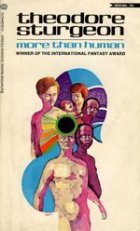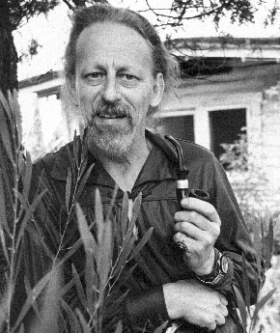There are two things I really appreciate about the Library of America and why I intend to use it as the path into American writers and the anarchist tension at the heart of our tradition. First, they do an excellent job of broadly defining the canon. By including the usual suspects (Melville, Twain, James) they also include science fiction, fantasy, horror, and noir genres. They also include political writing, economists, scientists, psychologists, and journalism. The only major hole I see is in Amerindian writers, but I suspect that will be filled eventually. The project is open-ended. They do this without ever sacrificing the quality of their contributions. Second, (and I am not trying to advertize for them, but simply praising this approach) their subscription system is affordable, flexible, and takes the approach that reading should be a life-long endeavor. I will be rushing things here, but I suppose I have the time.
Theodore Sturgeon is a well-known science fiction writer from the “square” generation (to use Asimov’s language in his preface to “Dangerous Visions” – he was including himself in that group). He had a very dynamic working life, that reminds one of Melville. He works as a sailor for three years, was a door-to-door salesman, and even ran a bulldozer. Indeed, he sounds like a great subject for the book I will someday write on mobility and labor. I confess I have not read much of his work, but he did write the Star Trek episode “Amok Time.” For those of you who do not remember, it is the one where Spock goes into heat and has to kill Kirk (I forget exactly why).
So, now his More than Human, the second novel in the LOA volume American Science Fiction: Four Classic Novels.
The story tells of the evolution of humanity from homo sapiens to homo gestalt. This concept reminds one immediately of Kropotkin’s Mutual Aid, which posits that human evolution was not competitive but rather cooperative. Kropotkin shows how many species survived and prospers through cooperation. Many anthropologists, primatolgists, and evolutionary psychologists have made this same point (See Sex at Dawn for a book that sums up this position, while making a case for the normalcy of human non-monogamy). Well, I guess homo gestalt could be the final stage of this mutual aid, but most leftist libertarians might say that we can get there without actually merging our consciousness. More Than Human also explores questions of social isolation, community, and institutionalization of difference (a major theme in Foucault, of course).
In Part One, “The Fabulous Idiot,” we are introduced to the vanguard of the new homo gestalt. The titular “Idiot” takes the name “Lone” after being adopted. “Lone” was a feral child, living in the woods, using his telepathic abilities (most effective against people with empathy) to survive. Another telepath, Evelyn, is killed by her father after starting a connection with “Lone.” “Lone” left his foster care after learning, telepathically, that they planned to send him off anyway – him being an adult, capable now of speaking, and because they are expecting a child of their own. He returns to his life in the woods and is joined by Jaine (a telekinetic), Bonnie, and Beanie (twins who can transport themselves). Lone finally brings his step brother to join them, a mechanical genius named “Baby.” Lone used his abilities to steal “Baby” from his foster father not long after his birth (Lone’s former foster mother died in childbirth). Part one ends with the creation, by the group, using the mind of Baby to invent an anti-gravity generator. They do this collectively, with each person playing a role in the new “body.”
Two things struck me in Part One. The first being the important role played by children in evolutionary history. “Descent with modifcation” implies that the gradual evolution of species (although usually impreceptable) takes place between generations. Progress – to accept uncritically Heackel’s view of evolution – requires the surrender of the old and the embrace of the youth. At this point in the novel, all the characters with power are young. Lone is not only young, but uncivilized and childlike. “He was a poor example of a man, but he was a man; and these were the voices of his children, the very young children, who had not yet learned to stop trying to be heard.” (165) As any parent likely knows, children have queer ideas, many of which cannot be disregarded as “childish” without peril. As unbelievable as Baby’s ability to construct in his month-old mind an anti-gravity device, is is a symbolic reminder that invention is often the domain of the young. In the examples of parents, we are confronted with people who cannot understand the children, or even violently resist their use.
I would also like to point out the powerful institutions played in the lives of these young characters. The full development of their power, as members of a little community, is only possible once they leave the institutions that bound them: the oppressive father, the indifferent parent, the foster parents.
Part Two, “Baby is Three”: This section is told in flashback in a psychiatrist’s office. We learn that Gerry Thompson took over the role of the “head” of the composite human. The main theme of this second part is the inability of the gestalt to remain intact when placed in the context of “normal” society. This question seems to me the most open to anarchist questioning since it seems to parallel questions about the degree that those of us sympathetic to anarchism can be authentic when we benefit from statism in many ways, or we benefit from the community. In the novel, Gerry learned that the gestalt had to leave Alicia’s (Evelyn’s surviving sister) home to survive as a composite form. We also find in this chapter the first systematic attempt to define the gestalt life-form. “What about this? You got a radio station, you got four-five receivers, each receiver is fixed up to make something different happen, like one digs and one flies and one makes noise, but each takes orders from the one place. And each one has its own power and its own things to do, but they are all apart. Now: is there life like that , instead of radio?” (278) As defined, it is not quite anarchy, there being a “head” or a leader, but the idea of a community of indispensable parts working cooperatively strikes one as a model of anarcho-communism, as envisioned by Kropotkin. As with Pohl and Kornbluth’s inability to imagine a green movement that was not based on central planning, we find a somewhat attractive alternative (cooperation, community, solidarity) with an unfortunate undertone of authoritarianism.
Part Three, “Morality”: The third section takes place eight years after and deals with the completion of the gestalt, with the addition of Lt. Hip, an Air Force engineer. It also covers the gestalt’s attempt to destroy the anti-gravational device, which Baby deemed a threat to human civilization. Hip’s entry into the gestalt not only completes it but ensures the redemption of Gerry, who has certainly tended toward evil actions – such as the killing of Alison in the previous section or the manipulation of psychiatrist. The solution to the problem posed above, that the gestalt still has a “head” and that the “head” can act immorally and therefore lead to unjust acts by the gestalt. The solution Sturgeon provides is the ethical code of Hip. I wonder if this is enough?
If we make a concrete parallel. We could all agree that a cooperative intentional community would have people of different skills, interests, and education. Collectively they would be able to achieve a diverse set of goals. Clearly there are examples of intentional communities where leaders misdirected those skills and energies. Would it be enough to include an ethicist into the intentional community? Would that along provide the conscience? Perhaps in this novel, the merging of entities, means those values would became generalized (like in the Borg), but in actual communities we are individuals and there is no evidence that our evolution future will transform us into slime molds.

